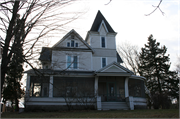| Additional Information: | 2017-2018 Report Recommendation: Dominated by a three-story tower, this Queen Anne-style house is largely sheathed with clapboard; however, the tower and peak trim features decorative shinglework. A screened porch wraps around the house on the north and to the west. Gabled wings to the east and west feature cutaway corners with wooden bracket detailing. Windows throughout the house are one-over-one-light sash arranged singly and in pairs.
Built circa 1889-90, this was the home of the superintendent of the Oaklawn Stock Farm, George H. Seely. Oaklawn Stock Farm was established in 1889 by Capt. Andrew Tainter, Seely’s father-in-law. Tainter came to Menomonie in 1846 and, four years later, joined the lumber firm of J.H. Knapp and it was renamed Knapp & Tainter. In 1853, Henry L. Stout joined the firm. In 1878, it was formally incorporated as a corporation under the name of Knapp, Stout & Co. While still actively engaged with the lumber company, Tainter established in 1889 the Oaklawn Stock Farm to breed race horses, although the farm also included cattle, sheep and swine. Comprised of over 500 acres, the farm included a number of barns, along with its own water tower for watering cattle, as well as for use in the case of fire. The property included two tracks—one outdoor and one covered/indoor track. In addition to the superintendent’s (Seely) home, there was also a farmhouse for the hired help. Seely’s home was identified as having such “modern improvements” as hot water heat, bathrooms, closets, and electricity.
Born in New York, Seely came to Menomonie in 1869. Following work in the mercantile business, he joined Knapp, Stout & Co. as the superintendent of their furnishing department, after which he ran a livery (the building of which was built from funds provided by his father-in-law). While operating the livery, Seely served as the mayor of Menomonie in 1884-1885, during which time the city’s waterworks was extended. With an interest in veterinary surgery--and specific to horses--he reportedly taught himself enough to perform such operations. Although owned by Tainter, the idea of the stock farm appears to have originated with Seely and his interest in animals. Seely wed Lottie Tainter in 1871 and together they had four children. Capt. Tainter died in 1899. Seely continued as the superintendent until circa 1903, at which time the racing stock was sold. Seely then went on to work as a fire insurance agent. The farm was maintained by the Tainter family until 1948, when it was purchased by John P. Dale. He actively farmed the parcel until 1968 and continued to reside in the home until 1990. That year, development of the Stout Technology Park began. In 1997, the property was purchased by Maggie Foote and Les Popowski and the house began operations as the Oaklawn Bed & Breakfast in 1998. The home continues to be owned and operated by Foote as a bed & breakfast and is known as the Oaklawn Inn. |
|---|
| Bibliographic References: | Citations for information below: “Oakland (sic) Stock Farm,” Dunn County News, 13 February 1891, 10/1; George Forrester, ed., Historical and Biographical Album of the Chippewa Valley Wisconsin (Chicago: A. Warner, 1892), 752-53; L.J. Haines and E.G. Dean, Souvenir of Menomonie, Wisconsin (Menomonie, WI: Dunn County News Press, Spring 1897), 27.
Forrester, ed., Historical and Biographical Album of the Chippewa Valley, 752-53; Wisconsin State Census, 1905 and U.S. Federal Census, Population, 1910, Both available online at www.Ancestry.com, Accessed May 2018; Barbara Lyon, “Oaklawn Bed & Breakfast; Adventure Began in 1996, 7 June 2001, Available online at https://chippewa.com/oaklawn-bed-breakfast-adventure-began-in/article_c9445c65-c2b8-534f-81d9-5223e901fdf7.html, Accessed June 2018; Brief history of Oaklawn Inn available online at www.oaklawninn.com/history/, Accessed January 2018. |
|---|

